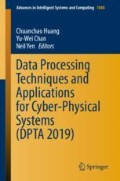Abstract
Dimensionality reduction refers to mapping data from high-dimensional space to a low-dimensional space, which is the main method of high-dimensional data mining. The restricted Boltzmann machine, the basic structure module of deep learning, is introduced and analyzed. The high-dimensional data reduction model based on restricted Boltzmann machine is established. At the same time, the validity has been verified theoretically and experimentally. It makes the depth model as compact and simple as possible without losing the precision, and the calculation speed is improved. Experiment results show that the model identification is of high accuracy. In particular, the depth model built by RBM based on the adaptive adjustment of hidden layer node units not only has high recognition accuracy, but also greatly improves the computing speed and saves the storage space.
Access this chapter
Tax calculation will be finalised at checkout
Purchases are for personal use only
References
Chen, Jie, and Yousef Saad. 2009. Lanczos vectors versus singular vectors for effective dimension reduction. IEEE Transactions on Knowledge and Data Engineering 21 (8): 1091–1103.
Mo, Dengyao, and Samuel H. Huang. 2012. Fractal-based intrinsic dimension estimation and its application in dimensionality reduction. IEEE Transactions on Knowledge and Data Engineering 24 (1): 59–71.
Zhao, Y., and S. Zhang. 2006. Generalized dimension-reduction framework for recent-biased time series analysis. IEEE Transactions on Knowledge and Data Engineering 18 (2): 231–244.
Yan, Jun, Ning Liu, Shuicheng Yan, et al. 2011. Trace-oriented feature analysis for large-scale text data dimension reduction. IEEE Transactions on Knowledge and Data Engineering 23 (7): 1103–1117.
Sedlmair, Michael, Tamara Munzner, and Melanie Tory. 2013. Empirical guidance on scatterplot and dimension reduction technique choices. IEEE Transactions on Visualization and Computer Graphics 19 (12): 2634–2643.
Pellet, Victor, and Filipe Aires. 2018. Bottleneck channels algorithm for satellite data dimension reduction: A case study for IASI. IEEE Transactions on Geoscience and Remote Sensing 56 (10): 6069–6081.
Farrell, M.D., and R.M. Mersereau. 2005. On the impact of PCA dimension reduction for hyperspectral detection of difficult targets. IEEE Geoscience and Remote Sensing Letters 2 (2): 192–195.
Zhang, Rui, Du Tao, and Qu Shouning. 2018. A principal component analysis algorithm based on dimension reduction window. IEEE Access 6: 63737–63747.
You, Wenjie, Zijiang Yang, Mingshun Yuan, et al. 2014. Totalpls: Local dimension reduction for multicategory microarray data. IEEE Transactions on Human-Machine Systems 44 (1): 125–138.
Yang, Wanqi, Yinghuan Shi, Yang Gao, et al. 2018. Incomplete-data oriented multiview dimension reduction via sparse low-rank representation. IEEE Transactions on Neural Networks and Learning Systems 29 (12): 6276–6291.
Author information
Authors and Affiliations
Corresponding author
Editor information
Editors and Affiliations
Rights and permissions
Copyright information
© 2020 Springer Nature Singapore Pte Ltd.
About this paper
Cite this paper
Zhang, J., Shen, J., Wang, T., Liu, K., Li, J. (2020). Dimension Reduction Algorithm of Big Data Based on Deep Neural Network. In: Huang, C., Chan, YW., Yen, N. (eds) Data Processing Techniques and Applications for Cyber-Physical Systems (DPTA 2019). Advances in Intelligent Systems and Computing, vol 1088. Springer, Singapore. https://doi.org/10.1007/978-981-15-1468-5_149
Download citation
DOI: https://doi.org/10.1007/978-981-15-1468-5_149
Published:
Publisher Name: Springer, Singapore
Print ISBN: 978-981-15-1467-8
Online ISBN: 978-981-15-1468-5
eBook Packages: Intelligent Technologies and RoboticsIntelligent Technologies and Robotics (R0)

